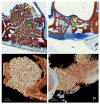Healing Patterns of Non-Collagenated Bovine and Collagenated Porcine Xenografts Used for Sinus Floor Elevation: A Histological Study in Rabbits
- PMID: 36547536
- PMCID: PMC9787467
- DOI: 10.3390/jfb13040276
Healing Patterns of Non-Collagenated Bovine and Collagenated Porcine Xenografts Used for Sinus Floor Elevation: A Histological Study in Rabbits
Abstract
Objective: To compare healing of collagenated and non-collagenated xenografts used for maxillary sinus floor elevation. Materials and Methods: Two different xenografts were used: deproteinized bovine bone (DBBM group) and collagenated corticocancellous porcine bone (collagenated group). Healing was studied after 2, 4, and 8 weeks. The loss of dimensions of the elevated area and the percentages of new bone, xenograft remnants, osteoclastic zones, vessels, inflammatory infiltrates, and soft tissues were analyzed. Three regions were evaluated: close to the bone walls (bone wall region), subjacent the sinus mucosa (submucosa region), and the center of the elevated area (middle region). The primary variables were the percentage of new bone and xenograft remnants. Results: Between 2 and 8 weeks, the elevated areas showed a reduction of 16.3% and 52.2% in the DBBM and collagenated groups, respectively (p < 0.01 between the two areas after 8 weeks). After 8 weeks, the highest content of new bone was observed in the bone wall region, which was higher in the collagenated group than in the DBBM group (41.6% and 28.6%, respectively; p < 0.01). A similar quantity of new bone was found between the two groups in other regions. A higher percentage of vessels in all regions evaluated (p < 0.01) and soft tissue in the sub-mucosa region (p < 0.05) was found in the collagenated group than in the DBBM group. Conclusions: The present study showed that both xenografts allowed new bone formation. In comparison with the non-collagenated xenograft, the collagenated xenograft underwent higher resorption, resulting in greater shrinkage of the elevated space after sinus lifting and a higher content of new bone in the regions close to the bone walls. Clinical relevance: In this study, the region adjacent to the bone wall showed the highest new bone content. This region resembles the base of the sinus, closest to the sinus floor and walls, and is the most important region from a clinical point of view because it is where the implant will be installed. Residues of the biomaterial remained after 8 weeks of healing. Other reports have shown that these biomaterial residues may interfere with the integration of implants.
Keywords: animal model; bone formation; bone regeneration; bone resorption; bone substitutes; sinus floor augmentation.
Conflict of interest statement
The authors declare no conflict of interest.
Figures








References
LinkOut - more resources
Full Text Sources

